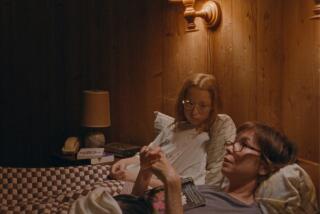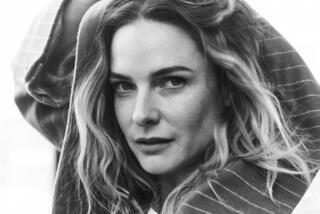A Place in His Heart : SET FOR LIFE, <i> By Judith Freeman (W. W. Norton: $19.95; 352 pp.)</i>
Judith Freeman attracted considerable attention with her two previous books, âFamily Attractionsâ--a volume of stories--and âThe Chinchilla Farm,â a novel. What was obvious in both was Freemanâs remarkable clarity in portraying characters and her luminous, often lyrical, prose. These gifts are confirmed in her second novel, âSet for Life,â which is starkly beautiful and focused with an almost laser-like intensity on her two protagonists.
In some ways, Freeman has found a classic--perhaps mythic--narrative in which two immensely unlike characters from utterly different realms of experience are brought together by serendipitous chance; these two lives merge, of course, and the situation of mutual, almost symbiotic, dependence that results is fascinating. (The technique was used, for example, by Russell Banks in âContinental Driftâ--a novel that somehow kept coming to mind as I read âSet for Life.â)
The main character is Phil Doucet, a retired builder who grew up in the Ozarks, a widower whose health at the outset of the story has reached a desperate crossroads. He must find a ânewâ heart quickly, or he will die. His sense of living on the delicate edge of existence is caught at once by Freeman:
âPhil Doucet awoke in the darkened room, jolted by sudden pains and the feeling he could no longer breathe. A great watery weight pressed down on him, as heavy as the sea. He sat up in bed and clutched his chest. His heart pounded urgently. He began panting, gasping for air. He grabbed at the sheets, arched his back, and held on. A knot like a bubble of gas moving under his breastbone expanded in his ribs. A sigh eased out of his mouth, and he began trembling. All he could think was, Itâs passed. . . . Iâm still alive.â
Freeman rarely lingers in a narrative cul-de-sac; indeed, the story drives ahead like an old-fashioned steam engine stuffed with coal, bringing Phil Doucet to a resolution of his heart crisis that is at once both exhilarating and sad, both obvious and far-fetched. Without giving away too much, let me say that Phil gets his new heart, and he is now--metaphorically--âset for life.â
Philâs world is luminously summoned, often from other points of view. One of his daughters, for example, is seen walking outside of his house: âAt dusk she went outside and walked down the narrow path that led through cottonwoods to the lake. Standing on the beach, which was marked by the tracks of geese, she turned and looked back at the house rising in the distance.â Freeman goes on, with lovely precision, to describe the stone house built by her father, its âglowing rock edifices with a webbing of wooden rooms.â Phil is pictured, through his daughterâs reflection, as an artificer of the old school, a man âwhose buildings were marked by his craftsmanship.â
This Old World engagement with stone, with craft, is set against a western wilderness that is described by Freeman with a poetâs sense of place, as in this description of Philâs grandson and two girls driving through the countryside:
âThey drove back to the highway and headed west on a road that curved around the end of the lake, riding through country that was dry and barren and rolling. They crested hills and dropped down into gullies where golden light illuminated sagebrush and skunkweed growing up to the shoulder of the road. They drove out to where low hills separated the shallow desert valleys and pools of stagnant water gathered in the bottom of ravines.â
Itâs the kind of writing, so vivid and concrete and sonorous, that makes âSet for Lifeâ stand apart from so much that is now being written. She conjures a haunting landscape that becomes, in effect, the landscape of her charactersâ imaginations, the backdrop against which their hopes and fears are played.
Louise Blanchard--the other protagonist--appears midway through the narrative. She stumbles, quite literally, into Philâs life, when he is on a picnic. She introduces herself with a beguiling frankness: â âIâm Louise,â she said, extending a pale hand. Phil couldnât believe how light her hand was when he took hold of it.â This frantic runaway, who is 16, will do anything to keep from being sent back to her father, the leader of a crazy neo-Nazi cult. âMy parents are crazy,â she tells him eventually. âI want to forget them. Theyâre poison.â
When we finally encounter her parents, near the end of the novel, we see what Louise means. In the interval, however, Freeman portrays a delicate to-and-fro between the elderly and still recuperating grandfather and the fragile, seductive and confused runaway. The development of their father-daughter type of relationship is dramatized in a moving way that testifies to Freemanâs novelistic skill. She focuses on the details of their life--cooking pancakes, driving around, eating cheeseburgers, watching television. Indeed, the very different ways in which American pop culture is processed by these extremely different characters and viewpoints is, in a way, one of the most alluring aspects of the story. (Once Louise enters the narrative, the novel becomes very much a latter-day and de-eroticized âLolita,â a story about an older man and a much younger woman on the loose in the wasteland of contemporary life).
The novel moves toward what is perhaps an inevitable climax. What matters in âSet for Lifeâ is not so much what happens to the relationship between Phil and Louise but how Phil Doucet wins the heart that he has, proleptically, âwonâ in the opening chapters by such extraordinary means. We see the change registered in Chapter 9, for instance, which opens: âHe awoke to a world totally new, a world awesome and forbiding outside his door.â Itâs the world that Phil will have to live in as the novel ends.
More to Read
Sign up for our Book Club newsletter
Get the latest news, events and more from the Los Angeles Times Book Club, and help us get L.A. reading and talking.
You may occasionally receive promotional content from the Los Angeles Times.







